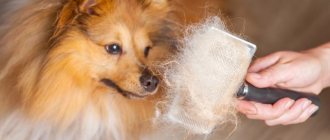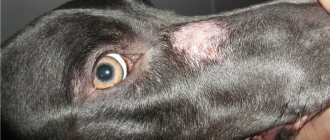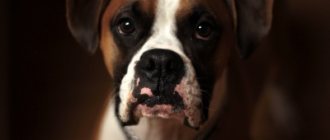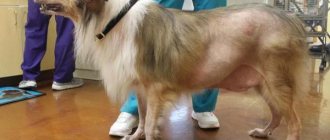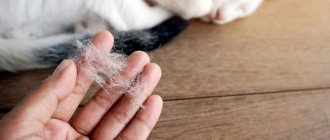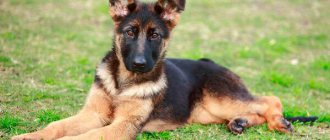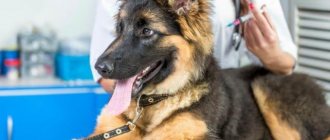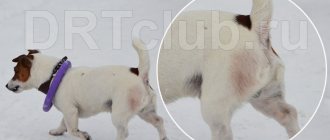Alopecia in dogs is a pathological condition accompanied by partial or complete hair loss in the animal. Impaired hair growth and baldness usually indicate internal or external problems in the dog’s body. The dog breeds most at risk are the Poodle, Staffordshire Terrier, Doberman Pinscher, Bulldog, Chow Chow and Miniature Pinscher.
Physiological reasons
Baldness of ears and other parts of the body in pets is not always associated with diseases. Hair loss can occur for the following reasons:
Age-related molting
If you have become the happy owner of a small puppy, you should know in advance about the upcoming changes that will soon begin to happen to your tiny friend.
The puppy’s very first coat is renewed at about a month and a half; at the same time, in some breeds the color changes from dark to light and vice versa. Age-related molting in a dog begins no earlier than six months, although there are also quite “early” individuals in whom this process begins upon reaching the age of three months. At this time, the “puppy” downy coat is replaced by a harder and denser coat. Typically this process lasts up to a year, although in some breeds the change in wool quality occurs over several years.
Please note that in addition to seasonal and age-related shedding, there are several other physiological circumstances that contribute to hair loss:
- Often whelped bitches who have recently finished feeding their offspring shed profusely;
- Severe hair loss is also typical for bitches before the onset of estrus.
Vitamins and preparations for hair restoration
A healthy dog has a beautiful, thick, even coat with bright color and shine. To ensure your pet’s appearance remains impeccable, its cover must be carefully monitored:
- Bath and brush according to breed recommendations;
- Use only animal-friendly products;
- Follow a diet, choosing high-quality products and feeds without allergenic additives.
During the shedding period, be sure to brush your dog daily to get rid of dead hair. Without this procedure, the pores become clogged, which leads to itching and irritation. If any unhealthy signs appear: bald spots, redness, you need to go to the clinic.
Another factor influencing the health of the coat is the sufficiency of the vitamin complex. All puppies and adult dogs need mineral supplementation. If dry food includes the necessary vitamins, then special additives are introduced for natural nutrition.
There are industrial wool growth tablets and nutritional supplements:
- Vit active S-SH (increasing hair density, improving structure; preventing destruction of hair follicles);
- Beafar (vitamin complex for healthy dermis and coat);
- Excel 8 in 1 (combination of garlic and brewer's yeast);
- Varieties of vitamins Canina ;
- Feed molasses and liver, flaxseed oil, brewer's yeast, lamb, whey (vitamins B, H, F);
Bedsores
Older or heavier dogs may be predisposed to bedsores when their elbows or other bony parts of the body regularly come into contact with hard surfaces. Over time, constant pressure leads to thickening of the skin, hair loss and calluses.
If calluses crack, bleed, or become infected, treatment may include moisturizers, antibiotics, or the use of retainers. You can prevent bedsores and calluses by providing your dog with soft bedding.
Diseases that cause hair loss in dogs
There are many different diseases that cause alopecia in animals. Let's look at the most common ones.
Fungal infections (mycoses). Affects mucous membranes and skin. Hair loss in dogs in a small area is the first sign. Redness, a white coating, small rashes, and blisters appear on the bald spot.- Hypothyroidism. A serious disease associated with the inaccessibility of the thyroid gland. Many metabolic processes in the body are disrupted and the level of stress hormones increases. Hair loss, swelling, lethargy are the main signs.
- Parasites. The presence of helminths in the body causes severe intoxication. The animal begins to have an allergic reaction and the skin is the first to suffer.
- Dermatitis. They are infectious, toxic and neurophysiological in nature. Neurodermatitis is especially common in small breeds of dogs. Chihuahuas often have bald ears for this very reason.
- Gastrointestinal diseases. In case of any digestive disorders, beneficial substances are absorbed worse. The body lacks nutrition and in addition to dyspeptic symptoms (belching, flatulence, vomiting), baldness, bleeding gums, weight loss, and the smell of rot from the mouth begin.
- Lack of estrogen (hyperestrogenism). Often found among spayed females. Due to a lack of the hormone, the dog’s fur becomes thinner, its growth and renewal slows down.
- Acanthosis nigricans. A skin disease caused by local accumulation of melatonin in the armpits and ears. In these places, skin dystrophy and hair loss are observed.
- Vitiligo. The disease provokes loss of pigment in the skin. The animal's head is the first to suffer.
- Adenitis of the sebaceous glands. The disease is characteristic of poodles and lapdogs. The main symptom is baldness of the face, ears, then the neck and back.
Of course, these are not all diseases that can provoke alopecia, but they are the most likely.
Diagnostics
First of all, the veterinarian will perform an external examination of the dog and take an anamnesis. Next, the doctor will choose one of the diagnostic methods to detect alopecia in a pet:
- Biopsy;
- Phototrichogram;
- Glow with an ultraviolet lamp;
- Biochemical, mycological and bacteriological studies of skin scrapings;
- General analysis of blood, urine and feces.
Read Nausea and vomiting in dogs: causes, signs and treatment
An ultrasound may be prescribed to examine the functioning of the thyroid gland. The activity of B- and T-lymphocytes in the blood, the content of antigens and protein are being studied.
Allergy
Often, ear sores appear as a sign of a full-blown allergy caused by an unsuitable food product, care product or medication. Even a previously unused vaccine can provoke the onset of an allergic reaction.
Identifying the problem is quite simple:
- Redness occurs on both the inside and outside of the ear.
- Constant itching forces the dog to inflict unnecessary wounds on itself.
- General swelling appears.
- Discharge from the eyes.
If you are absolutely sure that the cause of your poor health is an allergic reaction, then you can get rid of it with the help of antihistamines and by eliminating contact with the thing that causes such symptoms.
What to do if your dog's ears start to go bald?
Selecting effective treatment is only possible if the correct diagnosis is established. Taking any measures on your own is pointless and even dangerous. You can try to treat a symptom without eliminating its true cause. Meanwhile, the real disease will progress. The dog needs to be shown to a veterinarian. The specialist will prescribe a diagnosis. Primary analyzes include:
General and biochemical blood test.- Analysis of urine.
- Biochemical analysis of skin scrapings from the affected area.
- Biopsy (if necessary).
- Phototrichogram.
- Wood's lamp glow.
After the diagnosis is established, the animal is prescribed therapy on an inpatient or outpatient basis. Most diseases respond well to treatment. And the sooner the cause is identified, the sooner the pet will recover.
Diagnosis and treatment methods in a veterinary clinic
Only a veterinarian can make a final diagnosis for your pet after conducting a series of studies. These may include:
- taking anamnesis;
- Wood's lamp diagnostics;
- clinical analysis and blood biochemistry;
- hormone research;
- skin scraping;
- biopsy;
- stool and urine samples as additional diagnostic methods.
visual inspection;
Depending on the diagnosis, the four-legged patient will be prescribed complex therapy. As a rule, it may include one or more appointments:
- nutrition correction;
- special vitamins for wool;
- drugs for symptomatic treatment;
- remedies for fleas and other parasites;
- antibiotics;
- anti-inflammatory drugs;
- hormone therapy;
- antihistamines;
- treatment of affected areas with special ointments, solutions, shampoos.
The dog's hair is falling out, going bald, and bald spots appear.
Most dog owners know that if their pet's fur begins to actively fall out several times a year, there is no need to worry - this is a process of seasonal shedding. However, if this period is still far away, and the fur begins to become thin and actively fall out, the owners of the animal should be actively concerned about its health. It is also worth remembering that seasonal shedding does not in any way affect the general well-being of the dog, while hair loss or baldness, also known as alopecia, caused by illness or serious disorders of the body, can provoke other clinical signs, including, for example, lethargy , lack of appetite.
Hormonal diseases
If hair falls out symmetrically throughout the animal’s body, then most likely the cause is a hormonal disease. It can develop due to the following reasons:
- Impaired thyroid function (hypothyroidism). Accompanied by lethargy in behavior and decreased immunity. The hair falls out first on the neck and chest, then on the back, then moves to the limbs. The tail becomes bald only at the base.
- Estrogen deficiency. Usually seen in spayed females. The rate of hair growth decreases, the coat becomes thin and the skin becomes soft.
- Excess estrogen. It is observed in both males and females. Hair falls out on both sides of the body symmetrically. In females the vulva swells, in males the foreskin swells.
- Excess cortisol (Cushing's syndrome). Baldness is accompanied by weight gain and constant thirst.
- The use of hormonal contraceptives and other drugs that change hormonal levels.
- Impaired release of growth hormone into the body. Occurs in males during puberty.
Hormonal diseases are dangerous because they impair the functioning of the cardiovascular system. Before treating an animal, you need to show it to a veterinarian and conduct a comprehensive examination, the most important part of which is laboratory diagnostics, including determining the concentration of hormones in the blood.
Unbalanced diet
A lack of vitamins, amino acids and minerals leads to inflammatory reactions on the skin, itching, hair loss and flaking of the skin.
The main mistakes when feeding East European Shepherds (VEO) are as follows:
- Combination of natural and industrial feeding. Ready-made branded food is fully balanced in all nutrients. Therefore, if you supplement your dog with natural food, the balance is immediately disturbed.
- Self-feeding with vitamins. An incorrect selection of vitamins will lead to hypervitaminosis, which can also cause hair to fall out in clumps. If you want to give something to improve the condition of the coat, you can feed the dog an egg. It contains a lot of biotin, which is very beneficial for hair.
- The predominance of cereals in the diet. Dogs can easily tolerate porridge, but they are carnivores, so the most normal food would be meat and meat by-products. Therefore, you need to feed your German Shepherd tripe, lungs, kidneys, liver, bones and cartilage, and cottage cheese. Meat should prevail in the diet.
- Frequently feeding your pet liver. It has a very specific composition of proteins, amino acids, vitamins, and microelements. Therefore, frequent feeding leads to an imbalance of nutrients, which causes the shepherd to go bald.
- Feeding with fatty fermented milk products. Dogs' livers cannot digest cheeses, sour cream, cream and other foods with high fat content. You should also exclude pork from your diet, as it also contains a lot of fat.
Symptoms of feeding disorders are often the same:
- the shepherd itches and the hair falls out;
- gray hair;
- dandruff;
- bleeding gums;
- dryness, flaking of the skin;
- allergies.
Prevention measures
To prevent baldness in four-legged friends, veterinary specialists and experienced dog breeders recommend that owners follow the following rules for caring for animals:
- Feed your dog high quality food. When eating a natural diet, ensure a balanced diet.
- On the recommendation of a veterinarian, regularly give your pet multivitamin supplements for preventive purposes.
- Vaccinate against ringworm at the prescribed time.
- Avoid contact with stray animals.
- Follow the rules of grooming. Carry out water procedures regularly.
We recommend reading about vitamins for dog fur. You will learn about the signs of hypovitaminosis in dogs, problems with hair and skin due to vitamin deficiency, and vitamin complexes for pets.
Learn more about caring for your dog's coat.
Baldness in dogs is due to many reasons - from natural factors (molting) to serious hormonal diseases (Cushing's syndrome). Comprehensive diagnostics will allow you to identify the root cause of the pathology and prescribe effective treatment.
Possible causes of hair loss in dogs
There are many factors that can provoke active hair loss in an animal. All of them can be divided into two large blocks: hormonal and non-hormonal.
In order to determine the first causes, dog owners should take a closer look at the bald areas: if hair falls out on symmetrical areas of the body, the cause of hair loss most likely lies in hormonal disorders. But if the affected areas with missing hair are located chaotically, the cause of the pathology is absolutely not related to hormones.
Genetics
There are some "hairless" dogs, such as the Chinese Crested and the Mexican Hairless, but some dogs are more prone to hair loss than others. Hairless patches on the outer ear, chest, belly, hips, or lower neck can appear in Greyhounds, Beagles, Chihuahuas, Dachshunds, and Italian Greyhounds, usually after the first year of life.
Most owners learn to live with it as treatment options are limited. Always check to see if your veterinarian has ruled out other causes of hair loss.
Treatment of hair loss (alopecia) in dogs
There is simply no single, universal way to treat alopecia in dogs. Hair loss can be caused by a number of diseases (the most popular of which are described above), and subsequent therapy will depend entirely on the underlying cause. Dog owners should remember that only a specialist can correctly identify the catalyst disease, so trying to diagnose the cause of alopecia at home is not only useless, but also unsafe.
To determine the disease, tests are taken. So, to determine fungal and infectious diseases, a scraping is made with a special tape.
If the cause of the symptom is a hormonal imbalance, then the dog will be prescribed hormonal medications that will quickly restore the pet’s hormonal levels and fur.
If the cause of the hair loss is parasites, then the dog is prescribed drops that destroy ticks, fleas, lice and lice. A short course of medication will help get rid of helminths. At a veterinary clinic, you may be offered to use complex preparations that allow you to get rid of all pests at once (Advocate, Stronghold). In advanced cases, your doctor may prescribe antibiotics.
If the cause is decreased immunity, immunostimulating drugs are prescribed. In the future, it is better for some time to give the dog food containing special vitamin complexes for hair growth (Kino3).
However, dog owners can try to prevent hair loss by closely monitoring their dog's diet and immune system. In order for a pet to resist various infections, its diet must contain vitamin B, as well as essential minerals and beneficial microelements. In addition, the use of “human” shampoos and conditioners in animal care is unacceptable. Such cosmetics, as well as incorrectly selected shampoos for dogs, can cause serious allergies. That is why even such a seemingly insignificant choice should be made only after consultation with a specialist.
Methods of treating the disease
Treatment of dog hair loss must be done under the supervision of a veterinarian. Many infectious diseases can cause a sharp deterioration in the health of the animal, so it is better not to treat it yourself.
Baldness can only be treated using the traditional method if it is due to stress or poor nutrition.
First, the dog is fed carbohydrate food. If the reason still lies in nutrition, then the dog is switched to complete food.
If the pet does not eat food, then select the correct diet with. For example, these:
- meat;
- vegetables and fruits;
- seafood;
- cereals;
- kidneys and liver.
In addition, they give vitamins, growth yeast or combined medications. Such preparations are specially made for the development of the animal's fiber structure and its rapid growth. The dog can be wiped with high quality oil once a day. It softens and moisturizes the skin and coat well.
The thick and shiny coat of a pet is a source of pride for its caring owner. That is why it is no coincidence that such a problem as baldness in a dog raises serious concerns. The cause of alopecia in an animal can be either natural causes, such as molting, or serious fungal infections or diseases of the endocrine system. It is important for the owner to be able to recognize the type of baldness and take timely measures to eliminate the unpleasant phenomenon.
Read in this article
Symptoms
There is no single clinical picture for alopecia, since each type has its own set of manifestations. But they can be grouped:
- Baldness caused by allergies or demodicosis is characterized by itching, itching, and redness of the skin.
- With folliculitis, flea dermatitis, erythema, papules with serous fluid are formed. When the dog opens them, the pustules turn into ulcers.
- The fungal, viral and bacterial nature of baldness is accompanied by vomiting, loose stools and lethargy.
- With ringworm, you can find a rash, peeling, cracks, and crust formation on your pet's skin at the sites of damage.
- In addition to baldness, folliculitis is accompanied by increased body temperature, itching, the formation of pustules, and redness of diseased areas of the skin.
Hormonal causes of alopecia are asymptomatic, sometimes hyperpigmentation appears in the bald spot area. It is the multiplicity of manifestations, as well as their different nature, that makes diagnosis difficult. Therefore, to confirm the diagnosis, you need to conduct a comprehensive examination of your pet.
Causes of hair loss
Alopecia can be caused by various diseases and hormonal disorders.
On the neck
The first cause of hair loss in the neck area is the collar. When purchasing protection against parasites, you should choose proven brands to prevent allergic reactions in your animal. In addition, it is worth paying attention to the fact that:
- At the initial stage, thyroid dysfunction manifests symptoms in the designated area.
- Breeds that have folds in the neck area or excessively thick coats (Husky dogs) may develop yeast infections. If areas of hair loss are accompanied by inflammation and an unpleasant odor, contact a veterinarian immediately.
On the back, stomach, sides
The appearance of bald patches on an animal’s body can be a sign of many problems, mainly of a hormonal nature:
- Loss of fur on the belly and back in German Shepherd puppies, growth disturbances, dandruff, thin sensitive skin - signs are a lack of growth hormone. A rare disease, but worth knowing about. When the diagnosis is confirmed, synthesized drugs are prescribed to fill the missing element.
- If a dog, in addition to hair loss on the sides and belly, has swelling in the area of the reproductive organs, immediately contact the clinic. This is a sign of an excess of estrogen, which is treated with a surgical method, that is, removal of the organs responsible for producing the product. The sterilization process cannot be ignored or delayed; malignant tumors may develop.
- Baldness of the groin area in bitches is a sign of estrogen deficiency. Such disorders are treated by replenishing missing substances through injections.
- Hair loss over the entire surface, deterioration in its quality, changes in skin pigmentation, slow pulse - hypothyroidism. A thyroid disease that affects older dogs. Having confirmed the diagnosis, hormonal therapy is prescribed with drugs such as Levothyroxine.
- Widespread alopecia, accompanied by excessive thirst, inappropriate behavior, poor appetite, bloating, inflammation of the skin and cracks is an indicator of excess cortisol, a hormone responsible for controlling stressful situations. With such violations, the animal can be aggressive. The disease affects all dogs, but Dachshunds and Boxers are most commonly affected. Vetoril is used as therapy.
At the eyes
Hair loss in the visual area is most often caused by allergic reactions that cause:
- Improper nutrition with an excess of protein foods leads to poisoning and intoxication, the animal loses hair, eats poorly, and intestinal dysfunction occurs.
- Frequent bathing using aggressive detergents or special shampoos for dogs, which cause allergic reactions and, as a result, hair loss in the pet. It is recommended to wash animals no more than once a month, using simple products, such as tar soap.
- Eye diseases can also cause facial hair loss; a full veterinary examination should be performed.
The main reasons for the development of diseases
The causes of most ear diseases in dogs are the following:
- Allergic reactions.
- Ear injuries - bruises, bites, contusions, aggressive cleaning of the ears with rough and hard objects.
- Liquid ingress. For example, when swimming or in the rain.
- Severe hypothermia, drafts, living in a booth or cold room.
- Fungal or bacterial infection.
- Parasitic infection. For example, infection with ear mites.
- Entry of a foreign body. Sand, dust, insects, and lumps of dirt can become a source of infection and inflammation of the ear.
If there is any discomfort in the ears, the animal tries to get rid of it by vigorously scratching the itchy or sore spot. Since the tissues in this area are very thin and sensitive, abrasions and scratches form. Bacteria can get into them from a dog's claws, which subsequently leads to a secondary infection and further deterioration of the animal's condition.
Establishing diagnosis
It is impossible to independently determine the cause of canine alopecia, even with knowledge and practical experience. To make an accurate diagnosis, certain diagnostic procedures are required.
Before sending a four-legged patient for examination, the veterinarian assesses the condition of his skin and analyzes data received from the animal’s owner regarding how long ago this problem appeared, what symptoms it is accompanied by, whether the dog has suffered from any serious diseases in the past, and whether vaccinations are carried out regularly. and deworming. Information about the diagnostic procedures performed for dog hair loss is presented in the table:
Mr. Tail recommends: treatment and prevention of alopecia
The problems described above are only a small part of the diseases that cause hair loss. There are 5 main causes of hair loss:
- Allergies.
- Incorrect feeding.
- Hormonal imbalance.
- Parasitic infections.
- Stress.
Treatment for each specific case is considered separately. Self-diagnosis and therapy are strictly prohibited. Animals, like humans, have unique body characteristics that affect appearance, character and illness. Treatment for alopecia begins after tests and a detailed study of the dog’s medical record.
In addition, the doctor pays attention to food, places to walk and other features that owners often forget about.
Nevertheless, it is within the owner’s power to protect the pet from potential dangers. Preventive measures can and should be taken. There are 6 components of success that guarantee a dog a calm, healthy life:
- Regular treatment against parasites using properly prescribed products. They are different and are selected depending on the age, characteristics of the body and the character of the pet.
- Disinfection of food containers, sleeping places, clothes. They do this not only after infection, but constantly. Dishes are washed after every meal, bedding is washed once a week, clothes are washed after returning from a walk (especially if you were in the forest or walked in tall grass).
- Nutritional monitoring accompanied by medical consultations. Each dog is different and may not tolerate certain diets, so food selection and food substitutions are always risky.
- Taking care of your animal's immune system is important and requires a responsible approach. The pet needs a clear regime: food, walks, games. Dogs require attention and time no less than children.
- Vaccination cannot be ignored; it provides protection and builds immunity to many deadly diseases.
- Proper completion of the walk will help eliminate various diseases. It is necessary to comb the animal, check the fur for ticks and dirt. Wash your paws.
It is important to monitor the condition of the dog during the molting period, and look after the coat during pregnancy and feeding. During the season, you need to scratch your dog twice a day, this allows the coat to renew itself faster and eliminates the occurrence of dandruff, as well as digestive difficulties due to clogged intestines.
Other Features
- Seasonal shedding , in which dogs shed excess hair to facilitate thermoregulation. It is possible that shedding began precisely in the ear area.
- Thermal injuries (burns, frostbite) disrupt the structure of the skin, and it begins to peel off, thus getting rid of the damaged areas. The ears also become red.
- Lack of protein , which makes up any tissue of a living organism. If a pet leads an active lifestyle, its need for protein is higher. To restore muscles and bone tissue, in the absence of a sufficient amount of protein in food, it will destroy what it considers unnecessary tissue, converting it into nutrients.
- Deficiency of calcium and fiber , which also makes up the skin. Not only for construction, but also for maintaining all tissues, resources are needed.
- Stress. The fact is that the elements of the nervous system also consist of protein, calcium, sodium, fluorine and iron. Some elements are synthesized in a dog’s body in limited quantities and are used to restore the nervous system after stressful situations. Thus all tissues are deficient. The central nervous system has the highest priority among all systems, since it is a kind of “boss” of the body.
- Peeling can be caused by microclimatic conditions . If the house has air conditioning and it’s hot outside, the dog’s body will perceive this as a sharp change in the temperature of the environment and adapt its skin to protect itself. Some breeds are especially susceptible to this factor.
- In puppies during the period of active growth, peeling is observed due to the restructuring of the epidermal layer . New hairs are born in it, sebaceous glands are formed, and neural connections between receptors and skin are established. This changes the integrity of the cover, forming microtraumas that become covered with a fine crust, similar to a husk for us.
REFERENCE! General strengthening measures for peeling include taking vitamin complexes, lotions of natural herbal decoctions, including animal cartilage and joints rich in gelatin in the diet, stabilizing the rest and wakefulness regime, and active walks.
These tips will help not only with skin diseases, but also with strengthening general health and immunity .
Otodectosis
Ear mite damage is one of the most common causes of problems in domestic purebred dogs, since they have a much weaker immune system that does not protect against parasites. Even an animal that is not outdoors but comes into contact with other animals can become infected.
Almost all stray dogs are affected by this parasite.
Microscopic insects, falling on the inner surface of the auricle, bite under the skin and gnaw passages in it, feeding on particles of the epidermis and bloody secretions. Because of this, crusts and sores begin to form on the tips of the ears, and brown scabs appear, which are waste products of mites.
If the onset of infection is not noticed in time, then over time it will lead to the development of otitis media, and in particularly advanced cases it can provoke replenishment of the brain. Therefore, when you see the first mild signs of infection, you need to start taking action.
Additional signs of ticks are:
- Constant itching, disturbing the dog and forcing it to scratch the sore spot on all possible surfaces.
- Unpleasant smell.
- The appearance of sores and a gradual increase in their number.
- Too much dirt in the affected area.
When you contact the clinic, the doctor will take a scraping of the affected area of the skin and conduct the necessary examination, and then prescribe antiparasitic drugs and ointments.
If there is no opportunity to seek help at the moment, you can stop the proliferation of parasites by treating the sores with hydrogen peroxide, moving the pet to more comfortable conditions and increasing the diet.
Hematoma of the auricle
This is a traumatic injury that often accompanies bites, hits, or scratching in the ear area. It occurs due to a rupture of a blood vessel between the skin and cartilage. Blood pours under the skin, pushing the tissue apart and forming a fluid-filled “sac.” It looks like rapidly increasing swelling under the skin.
The hematoma is usually removed surgically. If a large cavity forms, splinting is required. If the owner leaves the damage unattended, the hematoma will gradually resolve, but the ear will remain disfigured forever. This should not be allowed, since a crooked ear can become a provoking factor for otitis media. If the hematoma becomes infected, for example due to scratching, then the course of the disease becomes significantly more complicated. The dog may lose an ear, lose hearing, or die due to infection.
Foreign body
If a foreign body gets into the ear, the dog presses and scratches its ears, whines, and shakes its head. The greatest danger is posed by thorns and spikelets of herbs, which can dig into the skin and cause suppuration. The foreign object should be removed as quickly as possible and hygienic treatment should be carried out. If the owner cannot remove the foreign body on his own, he should contact a veterinarian.
Deafness and hearing loss
A dog may not be able to distinguish sounds for various reasons, for example, due to swelling of the ear canal, its blockage with cerumen, or anatomical abnormalities (overgrowth, narrowing, etc.). The most difficult case is neurological diseases. The consequences vary, as do the treatment options. Some animals may be deaf from birth, while others may lose their hearing during life.
Other diseases
Neoplasms, hormonal imbalances, injuries, hereditary diseases, and the use of certain medications or other substances can also affect ear health. Therefore, never treat your pet yourself.
